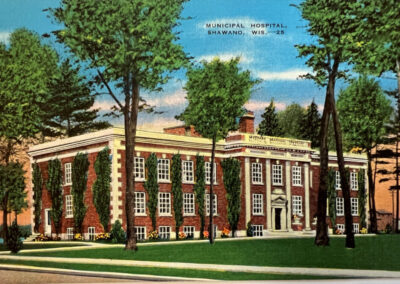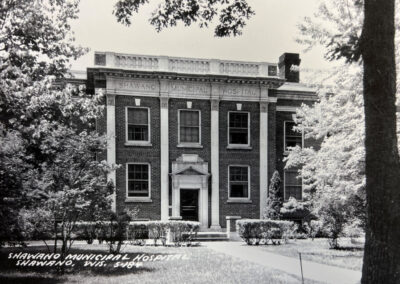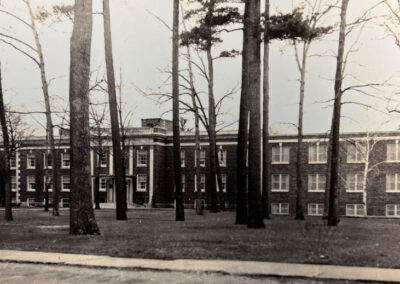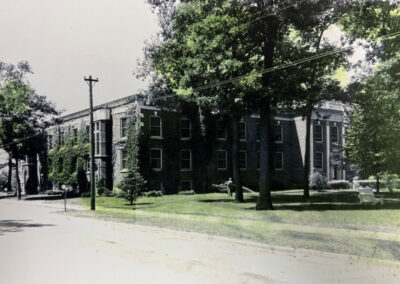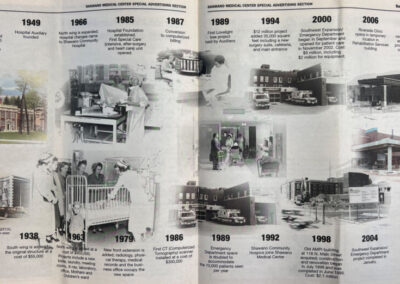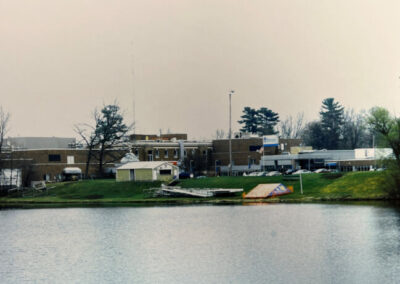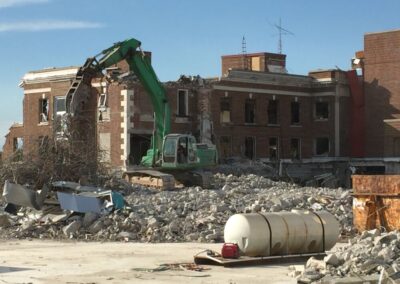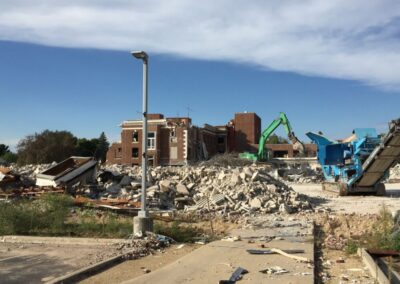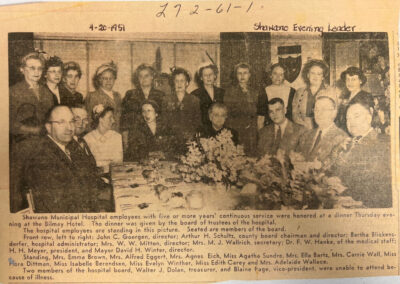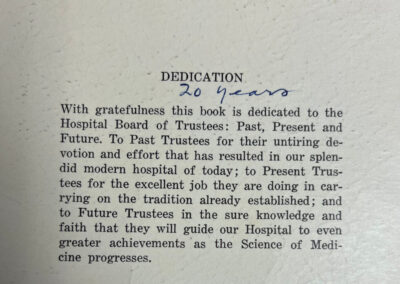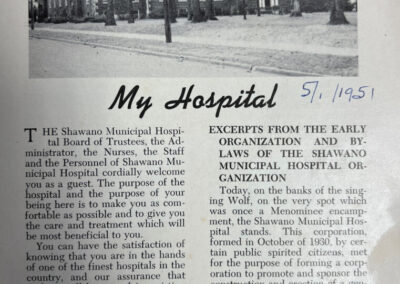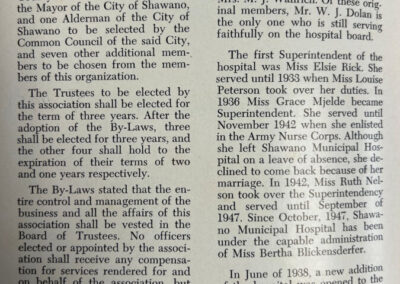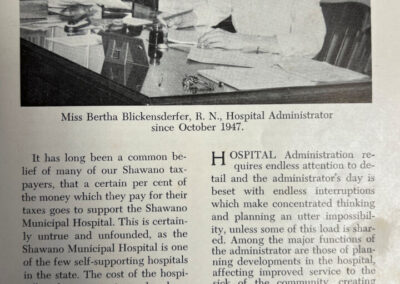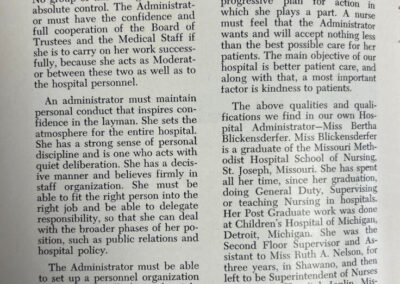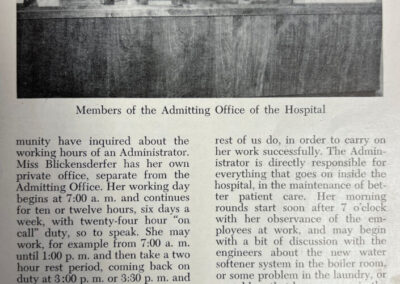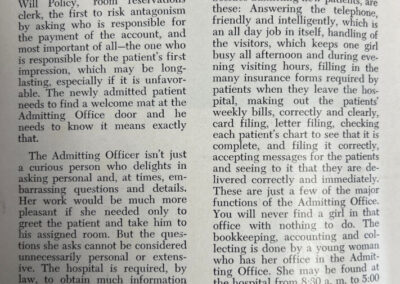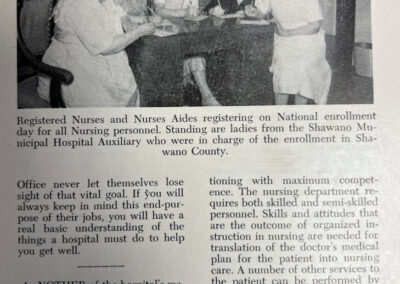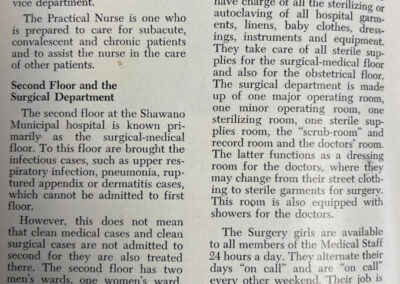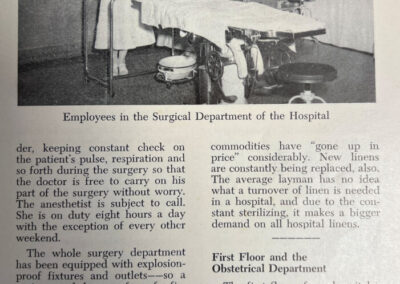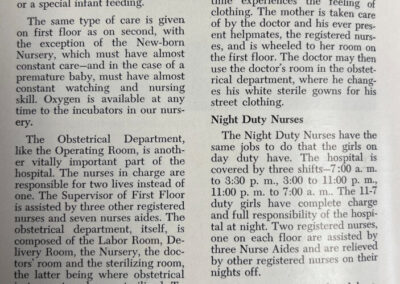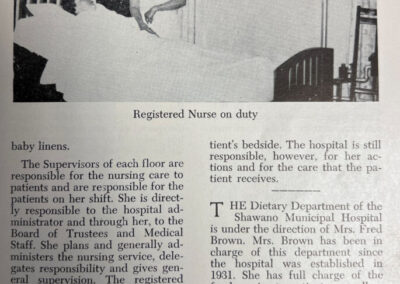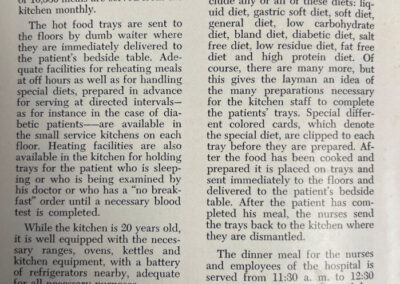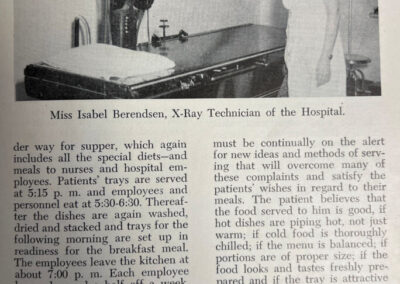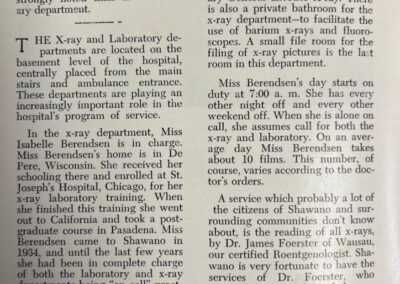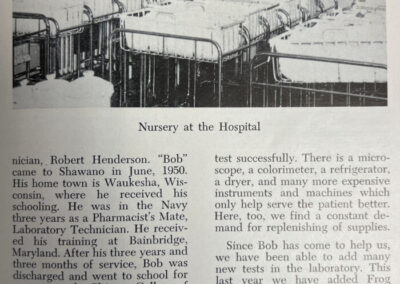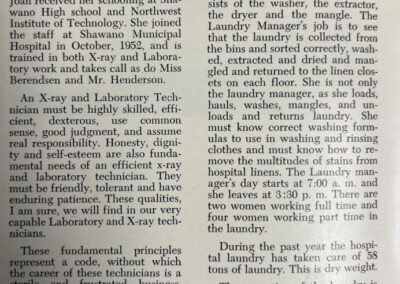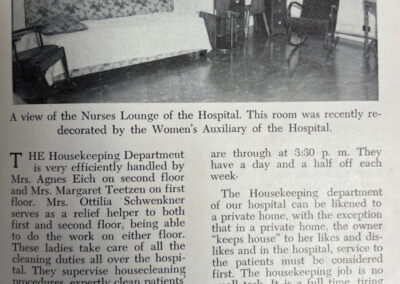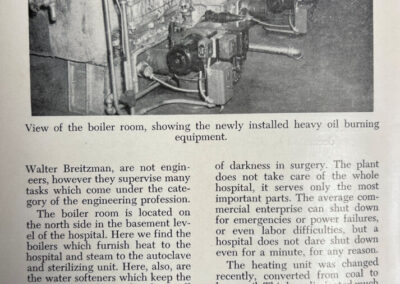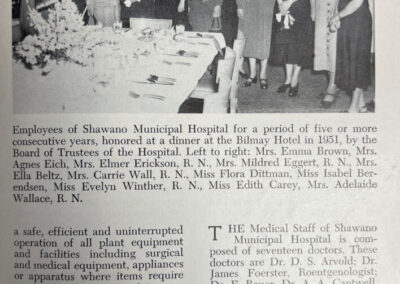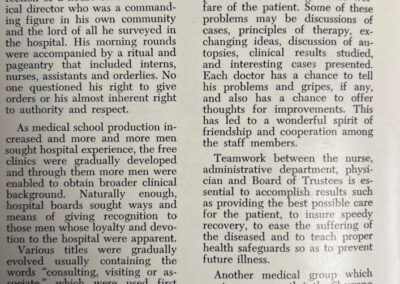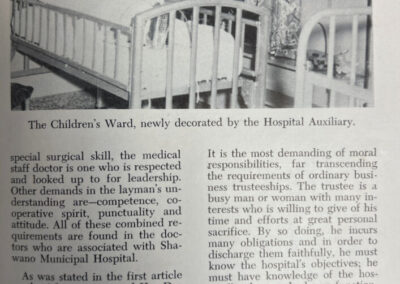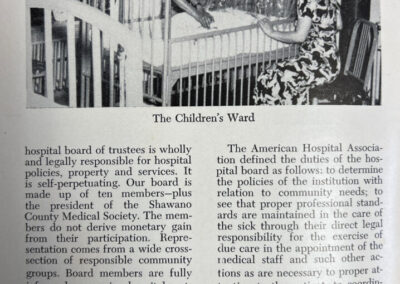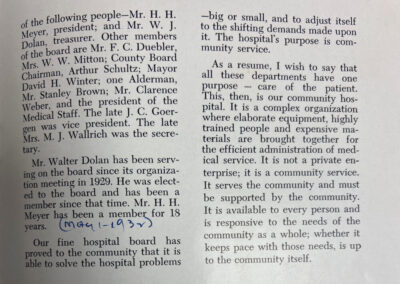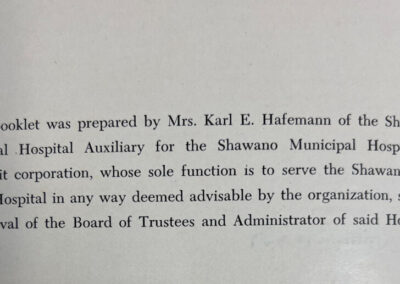Location
Photo Gallery
My Hospital – May 1951
A Brief History
Shawano Municipal Hospital
609 N. Bartlett Street
Shawano, Wisconsin
Shawano Municipal Hospital wasn’t Shawano’s first hospital. Back in the 1890’s Dr. Henry R. McComb built a house on Franklin Street and operated a more or less impoverished hospital in spare rooms. In 1910, Dr. Carl B. Stubenvoll leased the Edgar Reed house at 331 S. Main Street in Shawano and remodeled the house into a “hospital.” It had two wards with six beds and six private rooms. The fifteen beds available for patients were filled most of the time. In its nine years of operation, the hospital took care of 1,600 patients and some remarkable recoveries were made at the institution. Dr. Stubenvoll lost many thousands of dollars over the hospital’s nine years of operation and closed the facility before 1920. After Stubenvoll’s hospital closed, Shawano was left, once again, with no hospital for a city that grew from a population of 1,800 in the year 1900 to over 3,500 in 1920.
Over the next 10 years the topic of a hospital in Shawano was brought up at Advancement Association meetings and other organizations in the city and county. Nothing happend! However, in 1929 the topic got rolling in a big way. Committees were form to investigate financing, architecture, equipment, and organization. Different locations for Shawano Municipal Hospital were discussed and the property known as Smalley Park was agreed upon. The location was west of downtown, on the Wolf River and given to the city by the estate of Susan Smalley with the stipulation it be used as a park. Through a city council resolution, this stipulation was increased to read; for use as a public hospital and charitable facility with a 99 year lease.
In April 1930 the citizens of Shawano voted in favor of the community hospital. Construction started in 1930 and completed, ready for opening May 2-3, 1931. Original cost of the hospital and equipment totaled $95,000 with a “bed” capacity was 25. Two signicant additions were completed in 1938 and 1966. The south addition in 1938 added 50 beds with the tnorth addition in 1966 bringing the number of beds to 80. The architecture reflected a neoclassical building with moulded and modilioned cornice topped by parapet. It included jack arch lintels with keystone and a contemporary multilevel addition with vertical brick cornice.
The south wing provided increase bed capacity plus kitchen and refridgeration.
The north wing provided increased bed capacity and boiler, laundry, meeting rooms, laboratory, office, major and minor operating rooms, emergency room, mothers and children’s wards, special family meditation room and a large addition of the latest medical equipment.
1931 employeed – 10 with a salary of $12,587
1961 employees – 90 with a salary of $226,000
1971 employees – 137 with a salary of $511,309
All employees worked a full time, eight hour shifts, every day of the year
First Board of Directors
Anton Kuckuk
M. G. Eberlein Sr.
A. C. Weber
W. J. Dolan
Pearl Humphrey
Charles Koonz
Mrs. M. J. Wallrich
First Elected Officers
President: Anton Kuckuk
Vice President: A. L. Hammond
Secretary: Pearl Humphrey
Treasurer: A. C. Weber
Over the years the name of the hospital changed from Shawano Municipal Hosptial to Shawano Community Hospital and then to Shawano Medical Center. These name changes reflected the growth and evolutionary purpose of the organization. Shawano Medical Center and ThedaCare joined in 2010. Plans were put in place in 2011 for a new medical center to replace the Bartlett Street location which was closed in the fall of 2015 when the new medical center building opened. In 2016 the Bartlett Street medical and hospital center complex was torn down and the land left vacant for several years until the City of Shawano decided to partner with a firm to develop the site into single family homes.
***************************
The dream of Shawano Municpal Hospital – By KARL HAFEMANN
Shawano Municipal Hospital began as a dream. One man, Dr. Carl Stubenvoll, made the dream come true, tor a time, until the burden was too much tor him to bear alone.
Amy Amundsen, R.N. kept the dream alive, for tour years (1922-26). This is the story of how others caught the dream, and made it come true at last, in our hospital.
Back in the twenties, there was Advancement Association, this group, like the Chamber of Commerce, which was to succeed it, held an. annual dinner to hear reports of progress in Shawano. Each year the question of a hospital was brought up, and each year there was the saine report-“nothing accomplished.”
In 1929, THE group met as usual, for its regular banquet, reports, and discussion. When the chairman, Mr. Robert Upham was ready to adjourn, he found he had an unexpected speaker. Mr. Grover Boversdorf, who was then a storekeeper on Main Street, rose to ask why something was not done about the hospital. Each year, said Mr. Beversdorf, we meet and hear the same report, nothing doing. I can’t help but feel that the committee is not very enthusiastic about the project or they would have a different report. Maybe, they have put out a few feelers, and have been rebuffed, and so have thought that in dropping the matter they were doing what the people want. I think it that is the case, they have not gone far enough. I believe the people of Shawano want a hospital, and will support one. He went on to say — Right now, our mayor, Paul Winter, is in the hospital at Wausau. He’s lucky he had his accident near a town which had a hospital instead of here at home.
I think we should be ashamed that we do not have a hospital. I believe it would be of more value to use in the long run, than some of the new industries we are so anxious to get.
Some of you may be thinking that my mouth is bigger than my purse, but it our hospital is to succeed, it will need all of us, big and together.” Someone called out — Maybe we should get a new committee — and there was general laughter. I don’t think we need a new committee, Mr. Beversdorf replied, I think we just need a little more oil on the machinery we now have.
MR. BEVERSORF wasn’t the only one who had the dream in his heart, for when he sat down, Mr. L. D. Roberts, retired County Superintendent, rose to add his voice to the support of a hospital. Mr. Roberts, under whom many of the men present had gone to school, and who held the respect of all of them, kept his tone light, after supporting what had been said previously, he ended with — Of course I am not talking of this hospital because of myself. I don’t expect to need it! It’s some of you fellows I’m worried about.
Those “fellows,” listened to Mr. Roberts, politely, but the banter continued. Then Father Loerke rose. One of his hearers said it was the best talk he ever heard Father Loerke give, and it was all the more remarkable because it was extem poraneous. There is no record of Father Loerke’s exact words but his hearers were all quiet when he pointed out the necessity of putting First things First. He refused to believe there was lack of money, there was only lack of will, lack of a feeling of concern for the sick, or even for members of the of those present who might become sick.
If the dream had been dormant, it was revived that night. Oh yes! There were still scoffers, and the editor of the paper who reported the meeting said that Mr. Beversdorf had certainly provided some unscheduled amusement, and that the question of the hospital “Is still a vague one about which only time can tell.”
HE WAS WRONG in his guess that the question of the hospital was a vague one, for after the February meeting of the Chamber of Commerce just reported, Mayor Paul Winter brought up the matter of the hospital before the city council, and the first steps to make the dream a reality were taken. Many citizens, hearing that the council was about to discuss the matter attended the council meeting. Different citizens favor of the plan.
Mr. M. J. Wallrich offered to give a site, on Braun’s Hill (where the Charles Naber home is now located). Interest was so great the Mayor decided to call a mass meeting in April to which representatives all city organizations would be invited.
Meanwhile the plan was rolling. By the time of the mass meeting plans for financing a hospital had been drawn up. If the people wanted a hospital they would have to vote yes on a referendum to bond the city for $50,000.
The county would be asked for $15,000 and whatever else had to be raised would have to be raised by the citizens themselves. Feeling for the hospital ran high by the time of the April meeting, and the paper reporting it, came out with inch high headlines “Municipal Hospital Now Certain?” “500 give straw vote yes.” At the meeting M. J. Wallrich again offered the Braun Hill site of which he owned all the block but the homestead owned by the Brauns. Their corner would have to be purchased.
Dr. Stubenvoll who had done so called upon, and said that there was a definite need for a hospital, and that the hospital they were planning wouldn’t have the same difficulties which he faced in trying to finance a private hospital. Dr. Schroeder, seconded Dr. Stubenvoll’s words, and told of an actual case where hospital care might have saved a patient. Others called on to speak, were Mrs. Roger Cantwell, Mrs. W. C. Zachow, Mr. L. D. Roberts, Dr. Cal-kins, Mr. F. W. Humphrey, and Mr. John Kroll, who represented interest outside the city. The meeting was adjourned until later in April when more details were to be worked out.
THE CITY COUNCIL then approved the bond issue referendum and approved the appointment a committee of 36 people representing the organization of the city to work for the plan, and a smaller committee of four, Mr. M. J. Wallrich, Rev. Uhlig, Mr. Robert Fischer, and Mr. Albert Trathen to work out plans. Arguments were heard as to whether to raise the money for maintenance by endowment, or popular subscription.
By the time of the adjourned mass meeting, on April 22, it had been decided to raise $50,000, by popular subscription, in units of $10 each, and to erect a 24-room hospital, capable of caring for 35 persons. Mr. Albert Trathen was named chairman of the drive, and it was decided to make it a whirlwind affair finished by June 15. Enthusiasm ran so high that before the drive started on May 9, $11,050 had been pledged. By this time other sites had also been offered. Mr. Anton Kuckuk offered a five-acre site on the river, known as Kuckuk’s woods. This had beautiful trees and a quiet location but was so far off the main part town that sidewalks, streets and other improvements would have to be made before it could be used. Mr. F. W. Humphrey offered a site along the river, but this was also discarded as an idea, as was the site on Braun’s Hill. It was thought by some that the surface of the hill was so uneven, that much work would have to be done on it, and that the purchase of the Braun holdings would be too expensive. S,o the committee finally decided to accept the land offered by the city. The city had acquired a large block on the river from the Smalley estate, to be used as a city park. Permission was secured from the heirs of the estate to use this land for hospital purposes and the land was deeded to the hospital organization.
And so the solicitors started out to get the maintenance money which would make the dream come true. For the First ward the solicitors were Mr. Ed Iwen and Mr. Asa Green, for the second ward Mrs. C. P. Goddake and Mrs. John Gallagher Sr. For the third ward Mr. W. J. Schumacher and Mi. Harry Sanderson for the towns Wescott; Mr. W. J. Dolan; Richmond, Mr. Albert Engel; Waukechon, Mr. A. T. Osborn; Bonduel and Hartland, Mr. H. T. Rose; Herman and the town of Gresham, Mr. Barl Stier and Mr. Walter Schmidt; Red Springs, Mr. O. E. Morgan; Leopolis, Mr. Art Brunner; and for the towns of Cecil and Zachow, Mr. Ed Zachow.
BUT THE DREAM was not to be realized too quickly, by July 25, the total of subscriptions had climbed to $37,000. One solicitor had received half that amount from seventeen people. The big donations, had come in, from there on, Mr. Beversdorf’s prediction that big and small we had to all pull together, was to come true. During the summer, the Lion’s Club, the Chamber of Commerce and the Legion all pledged support and appointed committee to help in any way possible.
By October 29, 1929, the Chamber of Commerce banquet came around and there was more discussion. It was pointed out that while $12,000 still remained to be raise some areas had been canvassed completely, but others had not. For example, every working man living south of the Northwestern tracks had given for the hospital, on the other hand there were members of the Chamber of Commerce then. present who had not been solicited.
The County Board had already voted its quota of $15,000 and was thought that a new committee might replace the old, who had manifestly done well, but who had worked themselves out of enthusiasm. The mayor, Mr. Paul Winter, then appointed a committee of 8 young men to carry on the drive. After the appointment he remarked that he had not intended to appoint all Legion men as such, out it happened that all the men appointed to the new soliciting committee was Mr. Cap Wallrich, Mr. Oscar Dettman, Mr. Walte Mason, Mr. Robert Grade, Mr. Wallace Milsap, Mr. O. K. Ziebur, Mr. Morris Brener and Mr. Adrian Gansen.
FOLLOWING THIS committee appointment stories began to appear of corporations which were 100 percent as donors. By October 31, the drive had reached $43,480. There was still $6,520 to be raised and it takes many small donations to make thit sum.
IT WAS AT this time that the newspaper carried an editorial which was so prophetic I want to quote it to you. It appeared in the Leader Advocate of May 16, 1929. “Visualize our hospital. Place it in the center of a beautiful furnished in a modern way with everything for the comfort of the patient. Imbue it with that spirit of service which transforms four walls and a roof into a real house of healing, open its doors, invite in the sick and afflicted. See then come in great pain and suffering and go again cured – made whole. Help this dream come true. Th final responsibility is yours. The destiny of Shawano Hospital is in your hands. It can be done. Do your share!”
The drive seemed to have hit the doldrums again but it was not dead. Two of the solicitors refused to give up until the $50,000 goal was met. Citizens or Shawano owe a debt of gratitude to Mr. Wallace Milsap and Mr. Cap Wallrich who gave the last spurt of energy to get us over the top.
In April Shawano voted yes on the bond referendum, and by Apr 17, 1930, architects were meeting with the council and by July the bids were let for a building to cos $41,300. On the last day of July ground was broken for the building. The contractors were out of town men but some of the subcontracts were let to local firms.
That October, the corporation was formed, and the first officer the board, were Mr. Anton Kuckuk, Mr. A. L. Hammond, Mis Pearl Humphrey, Mr. A. C. Weber Dolan, Mr. M. G. Eberlien, Mr. W. J. Dolan, Mr. Charles Koona, and Mrs. M. J. Wallrich.
BY JANUARY, there were notices that donors should pay 30 percent down payment they had promised so that equipment could be purchased. There were also requests that organizations who would furnish a room would be welcome, to volunteer.
Now, the society columns were full of the doings of those organizations who were busy raising money for furnishings. The committee on furnishings, Mr. Kuckuk, Mr. Hammond, Mr. Weber, Mr. M. R. Stanley and Mrs. Wallrich began a series of junkets throughout this part of the state inspecting hospitals. One trip in particular that Mrs. M. J. Wallrich remembered they had started at dawn and swung south in their 1930 car to Reedsburg, to Oshkosh, and around to Wausau. The roads were not cleared as they are now and were glare ice too. The pilgrims turned around several times and slid down a hill once. It was midnight when they came to Wausau. Mrs. Wallrich said that she never wanted anything so much in her life as she wanted to register at the hotel there and stay until some of her family could come after her when driving condition improved. But she didn’t stay. in those days women were just beginning to be recognized in public work, and she felt that she was representing the women of Shawano, and that if she would give up when the men wanted to go on they would think she was a “pansy,” and that women on committee with men were liabilities rather than assets, so she gritted her teeth and came on to Shawano with the others. She got home at 4am.
The story of the selection of items for furnishings is another story. Mr. William Schumacher, who had a furniture store the Shawano Hardware is now located assembled a hospital room in his window so that contributors would know what the were buying.
The Woman’s Club gave a benefit asking two of the high school one act plays casts to give a public performance and help them raise their quota. The Presbyterian Aid had a mammoth bake sale, and sponsored a movie starring George Arlisax in Old English. The Four Wheel Drive showed its good will by contributing money to furnish two rooms. The story of the donations is too long for broadcast and will be given at some time in the future.
My March 5, 1931, the sidewalks were in, and opening day had ben set for the first part of May. That was the beginning of the realization of the dream. Shawano people had done their share and they had met their responsibility, and one again they shown that they could do a big job when they put their heads together. But as Mr. Beversdorf had prophesized, it had not been done by the rich men along, it had taken the help of all of us.
The Hospital Auxiliary is dedicated to the task of continuing that help, and invites Shawano people now as they were invited 25 years ago, to help make our hospital, a true haven of comfort imbued with that spirit of service which transforms four walls and a roof into a house of healing.

